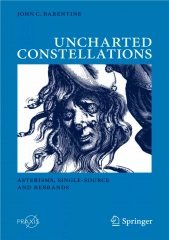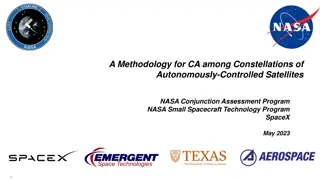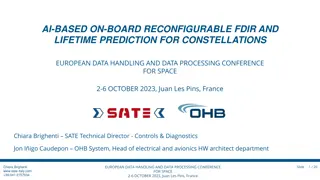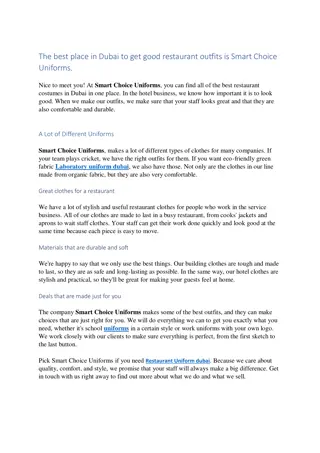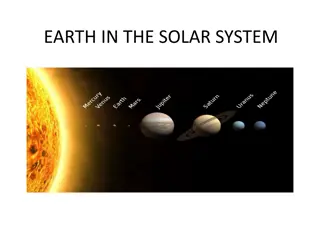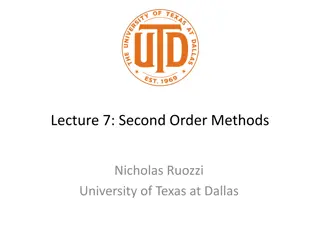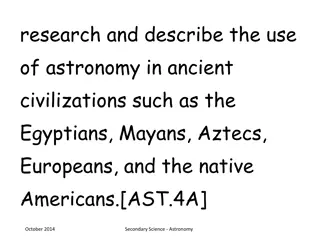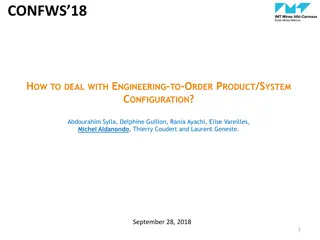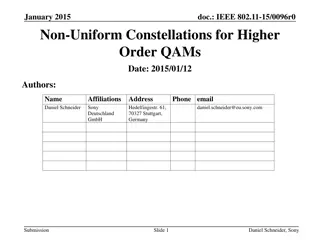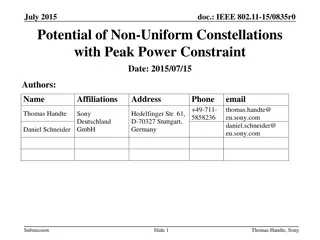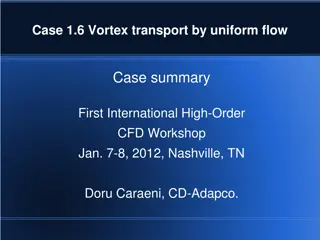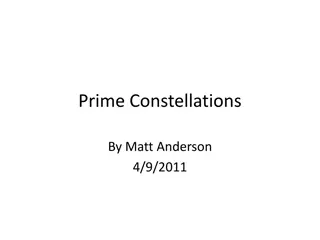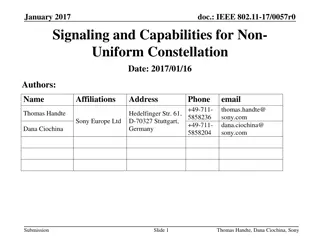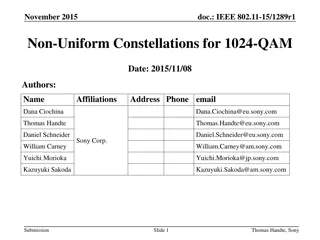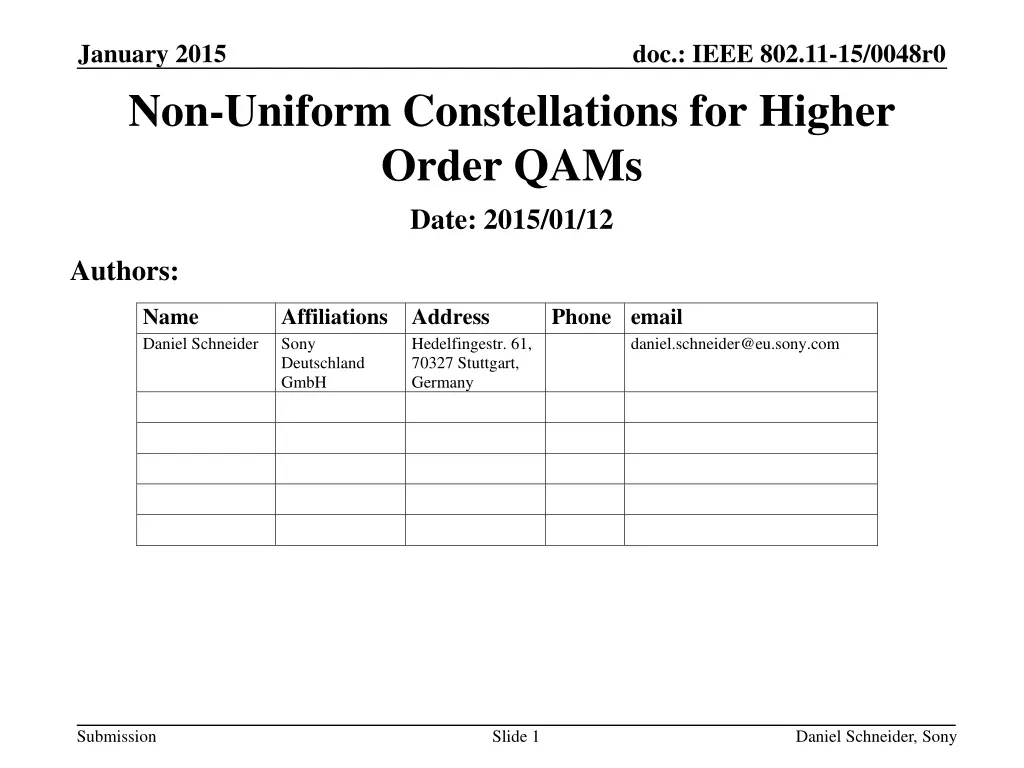
Non-Uniform Constellations for Higher Order QAMs in January 2015
Explore the advancements in non-uniform constellations for higher order QAMs discussed in January 2015, focusing on increased performance and optimum constellation point locations compared to uniform constellations. Learn about the introduction of NUCs in broadcast standards and the benefits of these constellations in achieving higher data rates and spectral efficiency. Discover the simulation results evaluating the performance gain of NUCs in different modulation schemes.
Download Presentation

Please find below an Image/Link to download the presentation.
The content on the website is provided AS IS for your information and personal use only. It may not be sold, licensed, or shared on other websites without obtaining consent from the author. If you encounter any issues during the download, it is possible that the publisher has removed the file from their server.
You are allowed to download the files provided on this website for personal or commercial use, subject to the condition that they are used lawfully. All files are the property of their respective owners.
The content on the website is provided AS IS for your information and personal use only. It may not be sold, licensed, or shared on other websites without obtaining consent from the author.
E N D
Presentation Transcript
January 2015 Non-Uniform Constellations for Higher Order QAMs Date: 2015/01/12 doc.: IEEE 802.11-15/0048r0 Authors: Name Daniel Schneider Affiliations Address Sony Deutschland GmbH Phone email Hedelfingestr. 61, 70327 Stuttgart, Germany daniel.schneider@eu.sony.com Submission Slide 1 Daniel Schneider, Sony
January 2015 doc.: IEEE 802.11-15/0048r0 Motivation (1/2) 1024-QAM discussed as potential technology for ax to increase peak data rate (indoor and in-room), e.g. [1] 25% increased spectral efficiency compared to 256-QAM 1Gbit/s with 1 spatial stream (160MHz, code rate 5/6, short GI) Non-uniform constellations (NUCs) provide increased performance compared to uniform constellations (UCs) Optimum location of constellation points Robust and weak bits carry optimum amount of information Submission Slide 2 Daniel Schneider, Sony
January 2015 doc.: IEEE 802.11-15/0048r0 Motivation (2/2) Introduced lately in several broadcast standards DVB-NGH [2], DVB/S2x [3] Theoretical shaping gain up to 1.5dB Moderate complexity increase Change of QAM (de)mapper Submission Slide 3 Daniel Schneider, Sony
January 2015 doc.: IEEE 802.11-15/0048r0 NUC: 1-D vs 2D 1D 16NUC for 3dB 1-D NUC: 16-QAM 1-D NUC I/Q symmetry 1-D demapping as for uniform constellations (UC), i.e. same order of demapping complexity 1 0.5 Im{xl} 0 -0.5 -1 -1 -0.5 0 0.5 1 Re{xl} 2-D NUC: 16-QAM 2-D NUC Symmetric quadrants Higher gain compared to 1-D NUC 2-D demapping required Submission Slide 4 Daniel Schneider, Sony
January 2015 doc.: IEEE 802.11-15/0048r0 Simulations: Parameters Replacement of original uniform constellations by NUC Basic MCSs: 0-9 Additionally: 1024-QAM FEC: LDPC Message Length: 1000bytes Channel AWGN Channel model B Gain evaluated compared to UC at FER=10-2 1D and 2D NUC MCS index 0 1 2 3 4 5 6 7 8 9 modulation BPSK QPSK QPSK 16-QAM 16-QAM 64-QAM 64-QAM 64-QAM 256-QAM 256-QAM 1024-QAM 1024-QAM 1024-QAM bit/symbol 1 2 2 4 4 6 6 6 8 8 10 10 10 coderate 1/2 1/2 3/4 1/2 3/4 2/3 3/4 5/6 3/4 5/6 2/3 3/4 5/6 Submission Slide 5 Daniel Schneider, Sony
January 2015 doc.: IEEE 802.11-15/0048r0 Simulations: Results Channel: AWGN Gain up to 0.95dB (2D NUC) and 0.75dB (1D NUC) for 1024-QAM gain compared to UC, LDPC, AWGN 1.2 1D NUC 2D NUC waterfall SNR gain [dB] @FER=1e-2 1 1024-QAM higher gain for higher constellations 0.8 256-QAM 0.6 64-QAM 0.4 16-QAM 0.2 0 MCS=0 MCS=1 MCS=2 MCS=3 MCS=4 MCS=5 MCS=6 MCS index MCS=7 MCS=8 MCS=9 CR=2/3 CR=3/4 CR=5/6 Submission Slide 6 Daniel Schneider, Sony
January 2015 doc.: IEEE 802.11-15/0048r0 Simulations: Results Channel: channel model B ~0.1dB smaller gain compared to AWGN results gain compared to UC, LDPC, channel model B 1.2 1D NUC 2D NUC waterfall SNR gain [dB] @FER=1e-2 1 1024-QAM 0.8 0.6 256-QAM 64-QAM 0.4 0.2 16-QAM 0 MCS=0 MCS=1 MCS=2 MCS=3 MCS=4 MCS=5 MCS=6 MCS index Slide 7 MCS=7 MCS=8 MCS=9 CR=2/3 CR=3/4 CR=5/6 Submission Daniel Schneider, Sony
January 2015 doc.: IEEE 802.11-15/0048r0 Conclusions Significant gain of NUC compared to UC Gain up to 0.6dB for 256-QAM Gain up to 0.9dB for 1024-QAM Moderate complexity increase Isolated change of QAM mapper and demapper Same demapper complexity as for uniform constellations for 1-D NUCs 2-D demapping required for 2-D NUCs Submission Slide 8 Daniel Schneider, Sony
January 2015 doc.: IEEE 802.11-15/0048r0 References 1. Eunsung Park, LG, 11-14-0624-00-00ax Investigation on 1024 QAM feasibility in 11ax 2. Next Generation broadcasting system to Handheld, physical layer specification (DVB-NGH), DVB BlueBook A160, 2012 3. DVB-S2X BlueBook A83-2 / EN302307-2 Submission Slide 9 Daniel Schneider, Sony
January 2015 doc.: IEEE 802.11-15/0048r0 BACKUP Submission Slide 10 Daniel Schneider, Sony
January 2015 doc.: IEEE 802.11-15/0048r0 NUC Example for different SNR Conditions 8NUC for low SNR 8PSK reference 8NUC optimized at 0 dB 1 1 bitwise BICM capacity for AWGN channel 20 bitwise BICM capacity for AWGN channel 8NUC for SNR = 0 dB 2 over-lapping points robust bits robust bits 0.8 0.8 1 0.6 0.6 0.5 100 000 110 010 0.4 Im{xl} 0.4 0 weak bits bit 0 bit 1 bit 2 bit 0 bit 1 bit 2 weak bits 0.2 0.2 -0.5 111 101 001 011 0 0 -10 -5 0 5 10 15 -1 -10 -5 0 5 10 15 20 SNR [dB] SNR [dB] -1 -0.5 0 0.5 1 0.0000+0.4859+0.4859= 0.9719 Re{xl} 0.1282+0.3973+0.3973 = 0.9229 Interpretation: weak bits carry no information, 2 most robust bits with maximum distance 8NUC for high SNR 8PAM reference 8ary hexagonal lattice 1 1 bitwise BICM capacity for AWGN channel bitwise BICM capacity for AWGN channel robust bits robust bits 0.8 8ary ideal hexagonal lattice 0.8 1.5 0.6 110 0.6 1 001 0.5 0.4 0.4 000 Im{xl} 100 weak bits 0 weak bits bit 0 bit 1 bit 2 bit 0 bit 1 bit 2 011 0.2 0.2 -0.5 101 010 0 -1 -10 -5 0 5 10 15 20 0 111 -10 -5 0 5 10 15 20 SNR [dB] -1.5 SNR [dB] 0.9393+0.9697+0.9697 =2.8787 -1 0 1 0.9749+0.9749+0.9779 =2.9276 Re{xl} Submission Slide 11 Eisuke Sakai, Sony Corporation Interpretation: hexagonal lattice = dense packing , maximize minimum Euclidean distance

